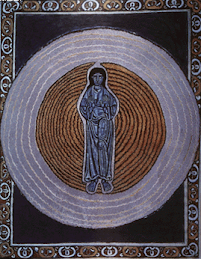Another
in a series of posts identifying some of the symbolism in the worship space of
St. Barnabas Episcopal Church, Glen Ellyn, IL.
Altar
Like
the Baptismal Font, the altar was designed by Richard Caemmerer. It is the
focal point
of our worship space representing the centrality of worship at St. Barnabas. Those who were here at the building’s groundbreaking tell us that the first spade of dirt was turned where the altar was to be. Unlike many churches, St. Barnabas intentionally has one altar and one main cross (the processional cross) emphasizing our unity around the one sacrifice of Christ.
of our worship space representing the centrality of worship at St. Barnabas. Those who were here at the building’s groundbreaking tell us that the first spade of dirt was turned where the altar was to be. Unlike many churches, St. Barnabas intentionally has one altar and one main cross (the processional cross) emphasizing our unity around the one sacrifice of Christ.
The
theme of eight recurs around the altar. The railing has eight sides, and the
brick foundation of the altar is three tiers with eight sides each. This
reminds us again that as we receive the Sacrament we are incorporated into the
promise of the eighth day and new creation.
The Lantern
Above
the altar is the "Lantern", a circular, lit, white pointed ceiling drawing our
eyes upwards to “the things that are above” (Colossians 3:2). The white circle,
with its two rings of light, represent the purity, light, and eternity of
heaven.
Below
the lantern is an uneven circle of wood representing the world as we know it –
uneven and broken by sin. Sixteen wooden beams (8X2) radiate from that uneven
circle making it into a symbol of the Crown of Thorns Jesus wore at his Passion
in which he identified with and transformed the brokenness, suffering, and sin
of this world.
Processional Cross
The
St. Barnabas processional cross stands next to the altar reminding us that the
Eucharist is a participation in the one sacrifice of Jesus on the cross. The cross was also designed by Richard
Caemmerer.
On
the horizontal arms of the cross are the Greek letters, Alpha and Omega (the
equivalent of A and Z), reminding us that Christ is first and last, the
beginning and the end. (Revelation 1:8)
At
the top of the cross is the Chi-Rho,
an ancient Christian symbol made of the first two Greek letters in
"Christ" – ‘X’ and ‘P’ (rho,
or ‘r’ in Greek) - superimposed on each other.
At
the bottom is another ancient symbol, a Christ monogram. It is a combination of
the ‘I’ (iota) and the ‘X’ (chi), the first letters of Jesus Christ
in Greek.
In
the center of the cross is the body of Jesus – the corpus (body). The presence
of the corpus makes this a crucifix. It is a reminder that in the incarnation,
God came to us enfleshed as a human body. In the Passion, Jesus shared in real
bodily suffering; and in his resurrection, Christ rose bodily from the grave
conquering death and establishing the promise of new creation.
The
placement of the cross next to the altar signifies that the Eucharist is always
a participation in the one sacrifice offered by Jesus. And it reminds us that
we can bring all our needs to the foot of the cross and that we are called
ourselves to take up the cross and follow Jesus.
"Reading"St. Barnabas V










No comments:
Post a Comment